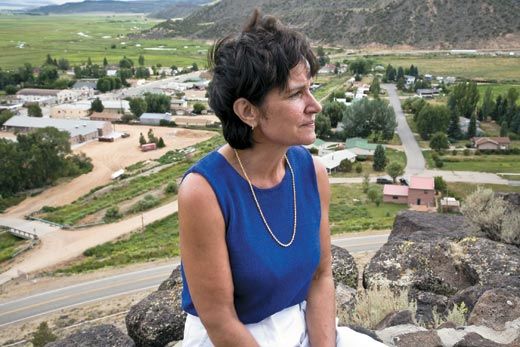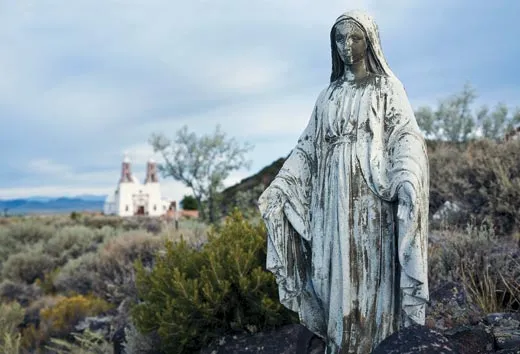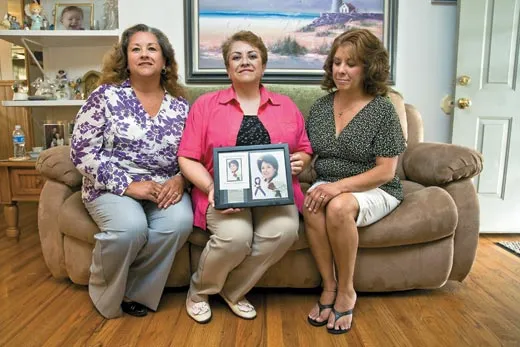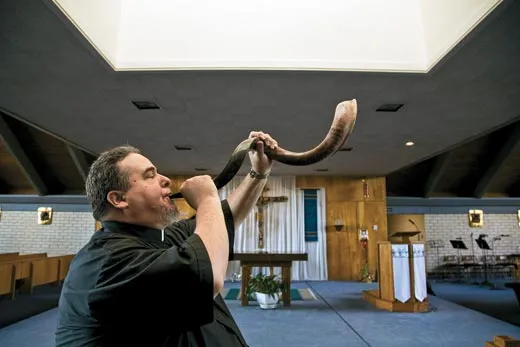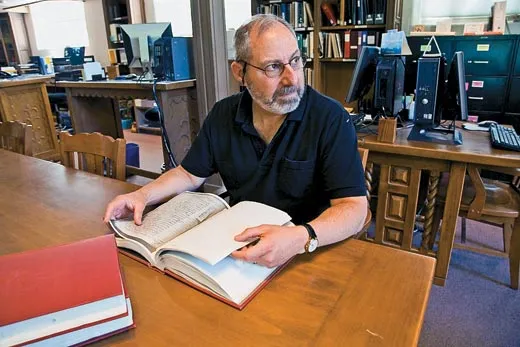The ‘Secret Jews’ of San Luis Valley
In Colorado, the gene linked to a virulent form of breast cancer found mainly in Jewish women is discovered in Hispanic Catholics
One September day in 2001, Teresa Castellano, Lisa Mullineaux, Jeffrey Shaw and Lisen Axell were having lunch in Denver. Genetic counselors from nearby hospitals and specialists in inherited cancers, the four would get together periodically to talk shop. That day they surprised one another: they'd each documented a case or two of Hispanic women with aggressive breast cancer linked to a particular genetic mutation. The women had roots in southern Colorado, near the New Mexico border. "I said, 'I have a patient with the mutation, and she's only in her 40s,'" Castellano recalls. "Then Lisa said that she had seen a couple of cases like that. And Jeff and Lisen had one or two also. We realized that this could be something really interesting."
Curiously, the genetic mutation that caused the virulent breast cancer had previously been found primarily in Jewish people whose ancestral home was Central or Eastern Europe. Yet all of these new patients were Hispanic Catholics.
Mullineaux contacted Ruth Oratz, a New York City-based oncologist then working in Denver. "Those people are Jewish," Oratz told her. "I'm sure of it."
Pooling their information, the counselors published a report in a medical journal about finding the gene mutation in six "non-Jewish Americans of Spanish ancestry." The researchers were cautious about some of the implications because the breast cancer patients themselves, as the paper put it, "denied Jewish ancestry."
The finding raised some awkward questions. What did the presence of the genetic mutation say about the Catholics who carried it? How did they happen to inherit it? Would they have to rethink who they were—their very identity—because of a tiny change in the three billion "letters" of their DNA? More important, how would it affect their health, and their children's health, in the future?
Some people in the valley were reluctant to confront such questions, at least initially, and a handful even rejected the overtures of physicians, scientists and historians who were suddenly interested in their family histories. But rumors of secret Spanish Jewry had floated around northern New Mexico and the San Luis Valley for years, and now the cold hard facts of DNA appeared to support them. As a result, families in this remote high-desert community have had to come to grips with a kind of knowledge that more and more of us are likely to face. For the story of this wayward gene is the story of modern genetics, a science that increasingly has the power both to predict the future and to illuminate the past in unsettling ways.
Expanding the DNA analysis, Sharon Graw, a University of Denver geneticist, confirmed that the mutation in the Hispanic patients from San Luis Valley exactly matched one previously found in Ashkenazi Jews from Central and Eastern Europe. The mutation, 185delAG, is a variant of a gene called BRCA1. When normal and healthy, BRCA1 helps to protect breast and ovarian cells from cancer. An extremely long gene, it has thousands of DNA letters, each corresponding to one of four chemical compounds that make up the genetic code and run down either strand of the DNA double helix; a "misspelling"—a mutation—can occur at virtually any letter. Some are of no consequence, but the deletion of the chemicals adenine (A) and guanine (G) at a site 185 rungs into the DNA ladder—hence the name 185delAG—will prevent the gene from functioning. Then the cell becomes vulnerable to a malignancy. To be sure, most breast and ovarian cancers do not run in families. The cases owing to BRCA1 and a similar gene, BRCA2, make up less than 10 percent of cases overall.
By comparing DNA samples from Jews around the world, scientists have pieced together the origins of the 185delAG mutation. It is ancient. More than 2,000 years ago, among the Hebrew tribes of Palestine, someone's DNA dropped the AG letters at the 185 site. The glitch spread and multiplied in succeeding generations, even as Jews migrated from Palestine to Europe. Ethnic groups tend to have their own distinctive genetic disorders, such as harmful variations of the BRCA1 gene, but because Jews throughout history have often married within their religion, the 185delAG mutation gained a strong foothold in that population. Today, roughly one in 100 Jews carries the harmful form of the gene variant.
Meanwhile, some of the Colorado patients began to look into their own heritage. With the zeal of an investigative reporter, Beatrice Wright searched for both cancer and Jewish ancestry in her family tree. Her maiden name is Martinez. She lives in a town north of Denver and has dozens of Martinez relatives in the San Luis Valley and northern New Mexico. In fact, her mother's maiden name was Martinez also. Wright had been diagnosed with breast cancer in 2000, when she was 45. Her right breast was removed and she was treated with chemotherapy. Later, her left breast, uterus, fallopian tubes and ovaries were removed as a precaution. She had vaguely known that the women on her father's side were susceptible to the disease. "With so much cancer on Dad's side of the family," she said, "my cancer doctor thought it might be hereditary." Advised by Lisa Mullineaux about BRCA testing, she provided a blood sample that came back positive for 185delAG.
When Wright was told that the mutation was characteristic of Jewish people, she recalled a magazine article about the secret Jews of New Mexico. It was well known that during the late Middle Ages the Jews of Spain were forced to convert to Catholicism. According to a considerable body of scholarship, some of the conversos maintained their faith in secret. After Judaism was outlawed in Spain in 1492 and Jews were expelled, some of those who stayed took their beliefs further underground. The exiles went as far as the New World.
For the first time Wright connected this history to memories of conceivably Jewish customs, such as sweeping dust into the center of a room and covering mirrors while mourning a loved one's death. She read up on the Spanish "crypto-Jews" in the library and on the Internet. In 2001, she and her husband made an extended visit to the valley and northern New Mexico. Tracking down as many of her paternal relatives as she could find, she alerted them to their dangerous genetic legacy and their ethno-religious heritage. "I have 60 first cousins, some I never knew I had," she says. "So I went fact-finding. I made the trek because I needed to know where I was from. 'Did you know about our Jewish heritage?' I said. It wasn't a big deal to some of them, but others kind of raised an eyebrow like I didn't know what I was talking about."
Part of New Mexico Territory until the U.S. government delineated the Colorado Territory in 1861, the San Luis Valley lies between two chains of mountains, the San Juans to the west and the Sangre de Cristos to the east. The Rio Grande begins here. The town of San Luis—the oldest in Colorado—is the Spanish heart of the valley. With an old church on the central plaza and a modern shrine on a mesa overlooking the town, San Luis bristles with Catholic symbols. It seems a short step back in time to the founding of the New Mexico colony, when picaresque gold-hungry conquistadors, Franciscan friars and Pueblo Indians came together, often violently, in a spare and sunburnt land. As Willa Cather put it in Death Comes for the Archbishop, perhaps the best novel about the region, the sunsets reflected on the Sangre de Cristo Mountains are "not the colour of living blood" but "the colour of the dried blood of saints and martyrs."
The discovery of the 185delAG mutation in the valley and subsequently in New Mexico hints at a different story, with its own trail of blood and persecution. The significance of the genetic work was immediately recognized by Stanley M. Hordes, a professor at the University of New Mexico. During the early 1980s, Hordes had been New Mexico's official state historian, and part of his job was assisting people with their genealogies. Hordes, who is 59, recalls that he received "some very unusual visits in my office. People would drop by and tell me, in whispers, that so-and-so doesn't eat pork, or that so-and-so circumcises his children." Informants took him to backcountry cemeteries and showed him gravestones that he says bore six-pointed stars; they brought out devotional objects from their closets that looked vaguely Jewish. As Hordes began speaking and writing about his findings, other New Mexicans came forward with memories of rituals and practices followed by their ostensibly Christian parents or grandparents having to do with the lighting of candles on Friday evenings or the slaughtering of animals.
Hordes laid out his research in a 2005 book, To the End of the Earth: A History of the Crypto-Jews of New Mexico. Following the Jews' expulsion from Spain, crypto-Jews were among the early settlers of Mexico. The Spanish in Mexico periodically tried to root out the "Judaizers," but it is clear from the records of trials that Jewish practices endured, even in the face of executions. According to Hordes' research, settlers who were crypto-Jews or descended from Jews ventured up the Rio Grande to frontier outposts in New Mexico. For 300 years, as the territory passed from Spanish to Mexican to United States hands, there was almost nothing in the historical record about crypto-Jews. Then, because of probing by younger relatives, the stories trickled out. "It was only when their suspicions were aroused decades later," Hordes writes, "that they asked their elders, who reluctantly answered, 'Eramos judíos' ('We were Jews')."*
But were they? Judith Neulander, an ethnographer and co-director of the Judaic Studies Program at Case Western Reserve University in Cleveland, was at first a believer of Hordes' theory that crypto-Judaism had survived in New Mexico. But after interviewing people in the region herself, she concluded it was an "imagined community." Among other things, Neulander has accused Hordes of asking leading questions and planting suggestions of Jewish identity. She says there are better explanations for the "memories" of unusual rites—vestiges of Seventh-Day Adventism, for example, which missionaries brought to the region in the early 20th century. She also suggested that perhaps some dark-skinned Hispanics were trying to elevate their ethnic status by associating themselves with lighter-skinned Jews, writing that "claims of Judaeo-Spanish ancestry are used to assert an overvalued line of white ancestral descent in the American Southwest."
Hordes disagrees. "Just because there are some people who are wannabes doesn't mean everybody is a wannabe," he says. But he acknowledges that Neulander's criticisms have made him and other researchers more cautious.
Hordes, pursuing another line of evidence, also pointed out that some of the New Mexicans he was studying were afflicted by a rare skin condition, pemphigus vulgaris, that is more common among Jews than other ethnic groups. Neulander countered that the same type of pemphigus vulgaris occurs in other peoples of European and Mediterranean background.
Then the 185delAG mutation surfaced. It was just the sort of objective data Hordes had been looking for. The findings didn't prove the carriers' Jewish ancestry, but the evidence smoothly fit his historical theme. Or, as he put it with a certain clinical detachment, it's a "significant development in the identification of a Jewish origin for certain Hispano families."
"Why do I do it?" Hordes was addressing the 2007 meeting, in Albuquerque, of the Society for Crypto-Judaic Studies, a scholarly group he co-founded. "Because the fabric of Jewish heritage is richer in New Mexico than we thought." His research and that of others, he said at the gathering, "rip the veneer off" the accounts of Spanish-Indian settlement and culture by adding a new element to the conventional mix.
One conference attendee was a Catholic New Mexican who heartily embraces his crypto-Jewish heritage, the Rev. Bill Sanchez, a local priest. He says he has upset some local Catholics by saying openly that he is "genetically Jewish." Sanchez bases his claim on another genetic test, Y chromosome analysis. The Y chromosome, handed down from father to son, provides a narrow glimpse of a male's paternal lineage. The test, which is promoted on the Internet and requires only a cheek swab, is one of the more popular genealogy probes. Sanchez noted that the test suggested he was descended from the esteemed Cohanim lineage of Jews. Still, a "Semitic" finding on this test isn't definitive; it could also apply to non-Jews.
Geneticists warn that biology is not destiny. A person's family tree contains thousands of ancestors, and DNA evidence that one may have been Hebrew (or Armenian or Bolivian or Nigerian) means very little unless the person decides to embrace the implication, as Sanchez has done. He sees no conflict between his disparate religious traditions. "Some of us believe we can practice rituals of crypto-Judaism and still be good Catholics," he says. He keeps a menorah in a prominent place in his parish church and says he adheres to a Pueblo belief or two for good measure.
At the Albuquerque meeting, the new evidence about 185delAG prompted discussion not only among academics but also among some of the subjects. Robert Martinez, no immediate relation to Beatrice Wright, teaches history at a high school near Albuquerque. During his summer vacations he helps Hordes sift through municipal and church records in Latin America and Europe, studying family histories and looking for references to Judaism. He traces his roots to members of the first expedition to New Mexico, led by Juan de Oñate, in 1598. The Spanish explorer himself had converso relatives, Hordes has found, and included conversos in the expedition.
When he went to work as Hordes' assistant ten years ago, Martinez, who is 45, was well aware of the disease in his family: several relatives have had breast or ovarian cancer. "Of course, I'd always heard about the cancer in our family on our mom's side," he says. "And then two of my sisters were diagnosed within months of each other." Both women tested positive for 185delAG and have since died. "I carry the mutation too," he says.
The Jewish connection caused no stir in his family, he says. "Me, I'm open. I want to know, Who am I? Where am I? We're a strange lot, New Mexicans. We refer to ourselves as Spanish, but we have Portuguese blood, Native American, some black too. We descend from a small genetic pool, and we're all connected if you go back far enough."
Teresa Castellano, the genetic counselor, has spent time in the San Luis Valley explaining BRCA to community leaders, patients and others. BRCA carriers, she tells them, have up to an 80 percent risk of developing breast cancer, as well as a significant risk of ovarian cancer. If a woman tests positive, her children would have a 50-50 chance of acquiring the flawed gene. BRCA mutations are passed down by men and women alike. If a family has mainly sons, the threat to the next generation may be masked.
A year and a half ago, Castellano got a call from a laboratory technician advising her of another patient with a connection to the 185delAG mutation. The patient's family had roots in the San Luis Valley and northern New Mexico. Their name was Valdez. At the top of the pedigree were eight siblings, two of whom, sisters, were still living. In the next generation were 29 adult children, including 15 females. Five of the 15 women had developed breast or ovarian cancer. Then came an expanding number of grandchildren and great-grandchildren, who were as yet too young for the disease but who might have the mutation. Only one or two members of the disparate clan still lived in the valley.
Ironically, Castellano's initial patient, Therese Valdez Martinez, did not carry the mutation herself. Her breast cancer was a "sporadic" case, not associated with a known mutation. But Therese's sister Josephine and her first cousin Victoria had died of ovarian cancer. Their DNA, retrieved from stored blood samples, tested positive for 185delAG. "Something's going on with our family," Therese said. "We need to wake up."
Castellano offered to hold counseling sessions with members of the Valdez extended family in April 2007. With Therese's backing, she sent out 50 invitations. A total of 67 people, including children, attended the session in a hospital conference room in Denver. Therese said, "One cousin—he won't come. He doesn't want to know. To each his own."
The tables were arranged in a U-shape, rather like the mountains around the valley. Castellano stood at the open end. She pointed out that in addition to breast and ovarian cancer the Valdez family had several cases of colon cancer. "There's some risk, it appears," Castellano said, "and therefore everyone in the family should have a colonoscopy at age 45." That caused grumbling among her listeners.
"This family has a lot of ovarian cancer," she went on, "but appears not to have a breast cancer case under age 35. So we think the age for women for starting their annual mammograms should be 30 to 35. We recommend that our '185' families do it by MRI every year. And if you do have 185," she added bluntly, "get your ovaries out at age 35."
A silence, then a question from a young woman in her 20s: "Can't a healthy lifestyle help? Do you have to have your ovaries out at 35?"
"Taking them out will decrease your risk but not eliminate it," Castellano said. Looking for support for this harsh measure, she smiled down the table at Angelita Valdez Armenta. Angelita had undergone the operation, called an oophorectomy. "Angie is a great example of how someone here is going to get old!" Months after the meeting, Angelita had her DNA tested and learned she was indeed a carrier of 185delAG.
The point of the meeting, which Castellano came to quickly enough, was to encourage family members to sign up for the DNA test. "Do you have to be tested?" she said. "No. But then you have to pretend you're positive and be more proactive about your health and your screening." Noting that the men were also at some risk of breast cancer, Castellano urged them to check themselves by inverting the nipple and feeling for a pea-sized lump.
Shalee Valdez, a teenager videotaping the session, put down her camera. "If you have the mutation," she wanted to know, "can you donate blood?" Yes. "Can it get into other people?" No, you had to inherit it. Shalee looked pleased. Castellano looked satisfied. As of this writing 15 additional Valdezes have undergone testing for the 185delAG mutation, with six of them testing positive.
Even Stanley Hordes, whose two decades of historical research has been bolstered by the 185delAG findings, says that the greatest value of the genetic information in New Mexico and Colorado is that it "identified a population at risk for contracting potentially fatal diseases, thus providing the opportunity for early detection and treatment." In other words, genes are rich in information, but the information that matters most is about life and death.
As she prepared for the Valdez family meeting, Castellano recalled, she wondered how the group would respond to what she had to tell them about their medical history. Then she plunged into her account of how 185delAG originated in the Middle East and traveled to New Mexico. The revelation that the Valdezes were related to Spanish Jews prompted quizzical looks. But, later, Elsie Valdez Vigil, at 68 the oldest family member there, said she wasn't bothered by the information. "Jesus was Jewish," she said.
Jeff Wheelwright, who lives in Morro Bay, California, is working on a book about the 185delAG breast cancer mutation.
Photographer Scott S. Warren is based in Durango, Colorado.
*Editor's Note: An earlier version of this article incorrectly translated 'We were Jews' as 'Erasmos judios.' Smithsonian apologizes for the error.
